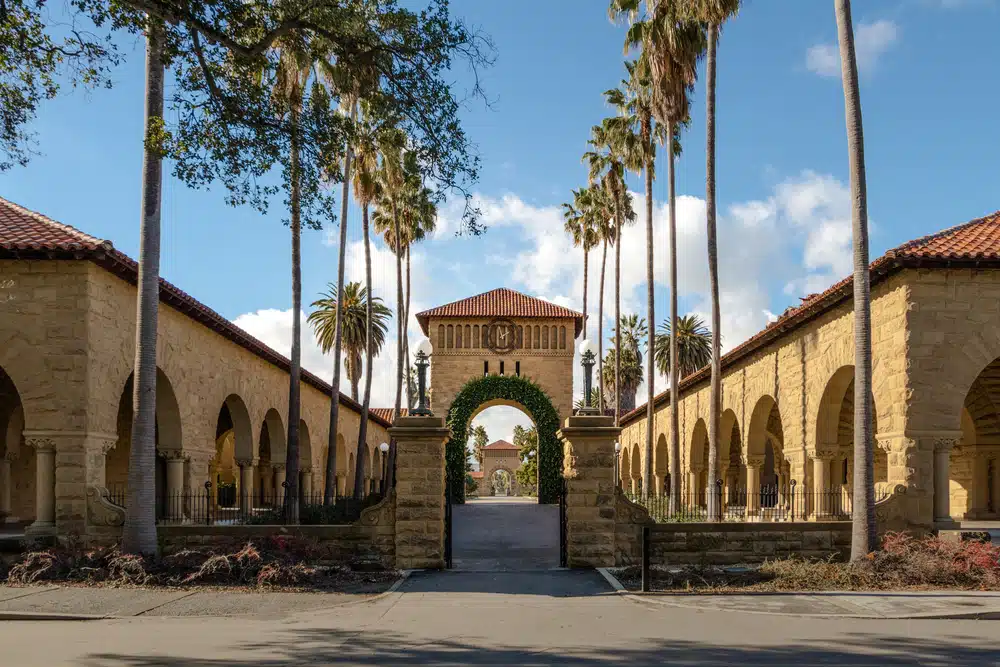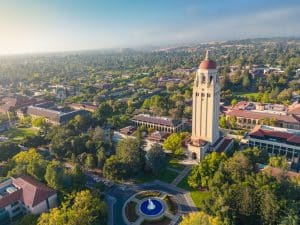Stanford Campus Tour
Stanford University, located in Stanford, California, is a hub of learning and innovation and a place rich with history and culture. Known for its beautiful campus and feats of architecture, the Stanford Campus Tour will showcase some of its most iconic locations and features.
Exploring the Historic Tour of Stanford Campus
The Stanford campus was established in 1885 and has a distinct architectural style that distinguishes it from many other campuses. The palm-lined avenues, Spanish colonial revival architecture, and expansive quadrangles combine beautifully to create an invigorating environment for study and play.
When you step onto the Stanford campus, you are immediately transported to a place where history and innovation coexist. The rich heritage of the university is evident in every corner, from the grand buildings to the meticulously maintained gardens.
The Main Quad: Heart of the University
At the center of Stanford’s campus lies the Main Quad, often considered the heart of the university. It’s the university’s oldest, most iconic building complex, hosting a variety of classrooms, offices, and museums. This beautiful circular space forms a hub of student activity, and its church and Memorial Arch are visual anchors for the entire campus.
As you walk through the Main Quad, you can’t help but feel a sense of awe and inspiration. The architecture is a testament to the vision of the university’s founders, with its grand archways and intricate detailing. The sound of students chatting and the rustle of leaves in the breeze create a vibrant atmosphere that is both energizing and peaceful.
One of the standout features of the Main Quad is the church, which stands tall and majestic, its spire reaching towards the sky. Inside, the church is a place of quiet contemplation, with stained glass windows casting colorful patterns on the polished wooden pews. It’s a place where students can find solace and reflect on their academic journey.
Hoover Tower: A Panoramic View
Standing tall in the midst of the campus, the Hoover Tower provides breathtaking panoramic views of the entire Stanford campus and beyond. Named after the 31st U.S. President Herbert Hoover, this tower serves as an observation deck and houses part of the Hoover Institution Library and Archives.
As you ascend the tower, the world unfolds before your eyes. The sprawling campus stretches out in all directions, with its lush green lawns and impressive buildings. On a clear day, you can see the distant mountains, their peaks capped with snow, creating a stunning backdrop to the campus.
Inside the tower, the Hoover Institution Library and Archives hold a treasure trove of knowledge. The shelves are lined with books, manuscripts, and historical documents, each one a window into the past. Scholars and researchers from around the world come here to delve into the archives, uncovering forgotten stories and shedding new light on the world we live in.
Exploring Stanford’s historic campus is like stepping into a living history book. Every building, every tree, and every pathway has a story to tell. It’s a place where the past and the present merge, where tradition and innovation walk hand in hand. Whether you’re a student, a visitor, or an alum, the Stanford campus will leave an indelible mark on your heart and mind.
Stanford Campus Tour: Academic Buildings and Libraries
Stanford’s cutting-edge facilities and vast libraries cater to a diverse range of disciplines. Let’s take a peek inside a couple of these institutions.
Green Library: Stanford’s Largest Library
Green Library, the main library of Stanford University, holds over 4 million volumes, making it the largest and most diverse collection within Stanford University Libraries. The Bing Wing of the library, acknowledged for its architectural prominence, is a favored spot for scholars and students alike for its tranquil ambiance.
As you step into the Bing Wing of Green Library, you are immediately greeted by the scent of old books and the soft rustling of pages being turned. The towering shelves, reaching toward the ceiling, are filled with countless volumes of knowledge spanning a wide array of subjects. From ancient texts to modern research papers, the collection in Green Library is truly awe-inspiring.
Wandering through the aisles, you may stumble upon a hidden gem, a rare book that transports you to a different time and place. The study carrels tucked away in quiet corners provide a sanctuary for deep contemplation and focused study. Natural light streams through the large windows, casting a warm glow on the wooden tables and inviting you to dive into the world of academia.
Outside the Bing Wing, the Green Library complex extends further, housing specialized collections and study spaces. The East Asia Library, with its extensive collection of materials on East Asian studies, offers a unique opportunity to explore the rich cultural heritage of the region. The Music Library, on the other hand, resonates with the melodies of classical compositions and contemporary tunes, providing a haven for musicians and music enthusiasts.
Stanford Campus Tour: The Science and Engineering Quad
The Science and Engineering Quad, often abbreviated as SEQ, brings together the school’s science and engineering disciplines. It’s a bustling hub of growth and innovation, playing host to exciting research projects and collaborative learning environments.
As you enter the Science and Engineering Quad, you are immediately enveloped in an atmosphere of scientific curiosity and technological advancement. State-of-the-art laboratories hum with the sound of experiments in progress, while students huddle together in study groups, brainstorming solutions to complex problems.
The SEQ is not just a place for academic pursuits; it is also a hub for interdisciplinary collaboration. Here, students from various fields come together to tackle grand challenges and push the boundaries of knowledge. Whether it’s designing sustainable energy solutions, developing cutting-edge medical technologies, or exploring the mysteries of the universe, the Science and Engineering Quad is a hotbed of innovation.
Walking through the quad, you might catch a glimpse of a robotics team testing their latest creation or a group of computer scientists discussing algorithms that could revolutionize artificial intelligence. The energy in the air is palpable, as ideas are exchanged and breakthroughs are made.
But it’s not all work and no play in the SEQ. The quad also offers spaces for relaxation and recreation. Lush green lawns invite students to take a break from their studies and soak up the California sunshine. Outdoor seating areas provide a gathering place for intellectual discussions and impromptu brainstorming sessions.
Whether you find yourself immersed in the world of books in Green Library or exploring the frontiers of science in the Science and Engineering Quad, Stanford’s academic buildings and libraries offer a vibrant and inspiring environment for intellectual growth and discovery.
Stanford Campus Tour: Student Life
Stanford offers a rich student experience with its homey residential halls and vibrant student unions, fostering a close-knit community of learners.
Residential Halls: Home Away from Home
The residential halls of Stanford University serve as a home away from home for the students. Having a variety of options like themed houses, dormitories, and fraternities/sororities, students can find the perfect fit for their college experience. The halls provide an environment conducive to learning, fostering friendships, and creating lifelong memories.
Imagine walking into your new residential hall at Stanford University, filled with excitement and anticipation. As you step into the cozy common area, you are greeted by the warm smiles of your fellow residents. The walls are adorned with vibrant artwork, showcasing the diverse talents of the student body. The air is filled with the aroma of freshly brewed coffee from the communal kitchen, where students gather to share stories and laughter.
Each residential hall at Stanford has its own unique charm. Some halls are known for their themed houses, where students with similar interests can live together and immerse themselves in a shared passion. Whether it’s a hall dedicated to the arts, sciences, or social activism, these themed houses provide a supportive and inspiring environment for students to thrive.
For those who prefer a more traditional dormitory setting, Stanford offers spacious and comfortable rooms that become a sanctuary for studying and relaxation. The dormitories are equipped with modern amenities, ensuring that students have everything they need to succeed academically and personally. From cozy study nooks to well-equipped communal kitchens, these dormitories foster a sense of community and camaraderie among the residents.
Fraternities and sororities also play a significant role in the residential life at Stanford. These Greek organizations provide a close-knit community within the larger university community. Students who join fraternities and sororities often form lifelong bonds with their fellow members, creating a network of support and friendship that extends far beyond their college years.
Tresidder Union: Hub of Student Activities
Tresidder Union is the central hub for student activities at Stanford. It houses a student lounge, food court, study zones, and the Stanford Bookstore. With various student organizations operating from here, Tresidder Union is always buzzing with energy and enthusiasm.
As you step into Tresidder Union, you are immediately greeted by the lively atmosphere. The student lounge is abuzz with activity, with students engaged in passionate discussions, studying together, or simply enjoying a moment of relaxation. The walls are adorned with colorful posters advertising upcoming events and showcasing the diverse range of student organizations on campus.
The food court at Tresidder Union is a culinary delight, offering a wide variety of cuisines to cater to every palate. From gourmet burgers to exotic sushi, there is something to satisfy every craving. As you savor your meal, you can’t help but strike up conversations with fellow students, sharing stories and recommendations for the best dishes to try.
For those seeking a quiet place to study, Tresidder Union provides designated study zones equipped with comfortable seating and ample desk space. Surrounded by the hum of focused students and the scent of freshly brewed coffee from the nearby café, you find yourself immersed in your studies, feeling motivated and inspired.
And let’s not forget the Stanford Bookstore, a treasure trove of knowledge and school spirit. From textbooks to Stanford merchandise, the bookstore is a haven for students looking to expand their minds and show off their Cardinal pride. As you browse the shelves, you discover hidden gems of literature and stumble upon unique Stanford memorabilia that will forever remind you of your time at the university.
With its vibrant student life, Stanford University ensures that students have access to a wide range of activities and resources to enhance their college experience. Whether it’s bonding with fellow residents in the residential halls or immersing yourself in the bustling energy of Tresidder Union, Stanford offers a supportive and engaging environment for students to grow, learn, and create lifelong memories.
Athletic Facilities and Outdoor Spaces
Stanford University is not only renowned for its academic excellence but also for its exceptional athletic facilities and breathtaking outdoor spaces. The university’s commitment to promoting health, wellness, and collegiate competition is evident in its state-of-the-art sports infrastructure.
When it comes to athletic facilities, Stanford truly stands out. The campus is home to a wide range of world-class sports facilities that cater to the needs of its diverse student body. From indoor arenas to outdoor fields, Stanford offers top-notch facilities for various sports and recreational activities.
One of the most impressive athletic facilities at Stanford is the iconic Stanford Stadium. With a seating capacity of 50,000, this historic provincial field becomes a vibrant hub of energy on game days. It serves as the home of the Cardinal, Stanford’s beloved football team. The stadium is not only a place for thrilling matches but also a symbol of pride and unity for the entire Stanford community. Students, faculty, and alumni gather here to cheer on their team, creating an electrifying atmosphere filled with the spirit of sportsmanship.
For those who seek a different kind of outdoor adventure, Stanford offers the renowned hiking trail known as “The Dish.” This iconic trail gets its name from the radio telescope located at its peak, which resembles a large dish. The Dish is a favorite spot among the Stanford community, providing a serene and picturesque escape into nature. As hikers make their way up the trail, they are rewarded with breathtaking panoramic views of the campus and the surrounding Bay Area. It’s a perfect opportunity to connect with nature, exercise, and appreciate the beauty of the Stanford landscape.
Additionally, Stanford’s commitment to promoting health and wellness extends beyond its athletic facilities. The university boasts a variety of outdoor spaces that encourage physical activity and relaxation. From beautifully landscaped gardens to expansive green spaces, students and faculty have ample opportunities to enjoy the outdoors and engage in recreational activities. These outdoor spaces not only contribute to the overall well-being of the Stanford community, but also serve as gathering places for socializing, studying, and finding inspiration.
Whether you’re a sports enthusiast looking for top-notch athletic facilities or an outdoor enthusiast seeking natural beauty and tranquility, Stanford University offers a remarkable array of options. Its world-class athletic facilities and stunning outdoor spaces truly reflect the university’s commitment to fostering a healthy and vibrant campus environment.
Art and Culture on Campus
Culture and the arts have a distinctive place in Stanford’s community. With its incredible arts center and concert hall, Stanford encourages creativity and artistic expression across disciplines.
Cantor Arts Center: A World-Class Museum
The Cantor Arts Center is a world-class museum that celebrates art from around the globe. With over 24 galleries featuring over 38,000 works spanning 5,000 years, Cantor provides a rich, diverse cultural experience for the Stanford community.
Bing Concert Hall: Center for Performing Arts
Bing Concert Hall serves as the epicenter for the performing arts at Stanford. This state-of-the-art facility hosts numerous concerts, performances, and presentations throughout the year, offering students and visitors a plethora of cultural experiences.
As we round off our virtual tour, we hope that you’ve gained a deeper insight into the incredible breadth and depth of the Stanford campus. Whether it be academics, student life, athletics, or the arts – there’s something captivating for everyone at Stanford.










































